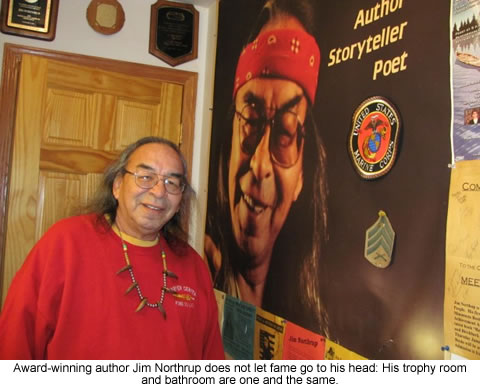 |
Canku Ota
|
 |
|
(Many Paths)
|
||
|
An Online Newsletter
Celebrating Native America
|
||
|
June
1, 2011 - Volume 9 Number 6
|
||
|
|
||
|
Jim Northrup:
Veteran, Wordsmith, Language Preserver
|
||
|
by Konnie LeMay Indian
Country Today
|
||
|
credits: Award-winning
author Jim Northrup does not let fame go to his head: His trophy
room and bathroom are one and the same.
|
 Award-winning
writer Jim Northrup, Ojibwe, is not just a storyteller. Along with
his wife, Patricia, Dakota, he is also known as a language warrior
for reviving Ojibwe. And he keeps alive such traditions as sugarbush,
the tapping of maple trees for sap, and making birch-bark baskets. Award-winning
writer Jim Northrup, Ojibwe, is not just a storyteller. Along with
his wife, Patricia, Dakota, he is also known as a language warrior
for reviving Ojibwe. And he keeps alive such traditions as sugarbush,
the tapping of maple trees for sap, and making birch-bark baskets.
Born on the Fond du Lac Reservation in northern Minnesota, Northrup was one of 12 children. He attended boarding schools in Minnesota and South Dakota and did a stint in reform school—charged with “aggravated buffoonery with intent to mope,” as he put it—before graduating high school in Carlton, Minnesota. He joined the U.S. Marines and served for five years, including in Vietnam. Settling in Sawyer, Minnesota, he lived a mile off the road in a $600 tipi from a catalogue. “I liked the solitude of it. Quiet.” During the evenings Northrup, with his friends and family, told stories around the fire. His tales had them “falling off the log, laughing” and begging for more, he said. At one point he realized that his tale of Luke Warmwater looked a lot like stories he had read, and he began publishing. His poetry and prose have appeared in many forms, including several books, and a column, the “Fond du Lac Follies.” He has been mentored by such well-known Anishinaabe writers as Gerald Vizenor and Louise Erdrich and was the subject of a documentary that won numerous awards, Jim Northrup: With Reservations. He has eight children, “someplace between 15 and 20” grandchildren and a great-grandchild. He lives with Patricia near Sawyer, among their children and his siblings. A collection of Northrup’s columns, Anishinaabe Syndicated: A View from the Rez, has just come out from the Minnesota Historical Society Press. Read a review and an excerpt. Meanwhile, Indian Country Today Media Network caught up with the author himself at home. ICTMN: Why choose the Marines? How did you come to writing? How do you decide whether
to use poetry or prose for a story? Do you keep to tradition? What’s next? You’ve traveled a
lot. As an Ojibwe, how are you received? Note: Paul and I are honored to call Jim a friend.. |
|
|
||
|
|
||
| Canku Ota is a free Newsletter celebrating Native America, its traditions and accomplishments . We do not provide subscriber or visitor names to anyone. Some articles presented in Canku Ota may contain copyright material. We have received appropriate permissions for republishing any articles. Material appearing here is distributed without profit or monetary gain to those who have expressed an interest. This is in accordance with Title 17 U.S.C. Section 107. | ||
|
Canku Ota is a copyright ©
2000, 2001, 2002, 2003, 2004, 2005, 2006, 2007, 2008, 2009, 2010,
2011 of Vicki Barry and Paul Barry.
|
||
 |
 |
|
|
The "Canku
Ota - A Newsletter Celebrating Native America" web site and
its design is the
|
||
|
Copyright ©
1999, 2000, 2001, 2002, 2003, 2004, 2005,
2006, 2007, 2008, 2009, 2010, 2011
of Paul C. Barry.
|
||
|
All Rights Reserved.
|
||